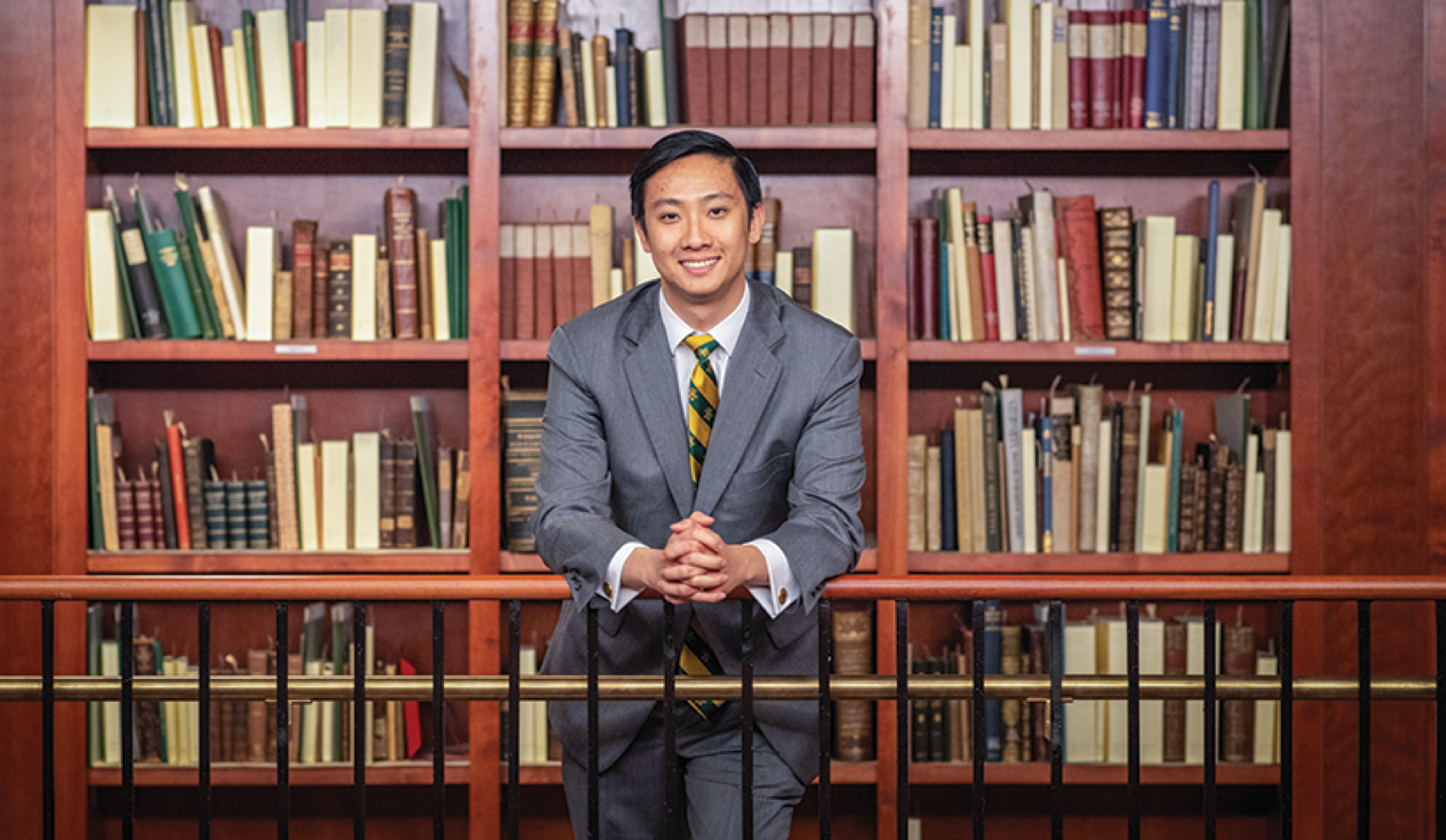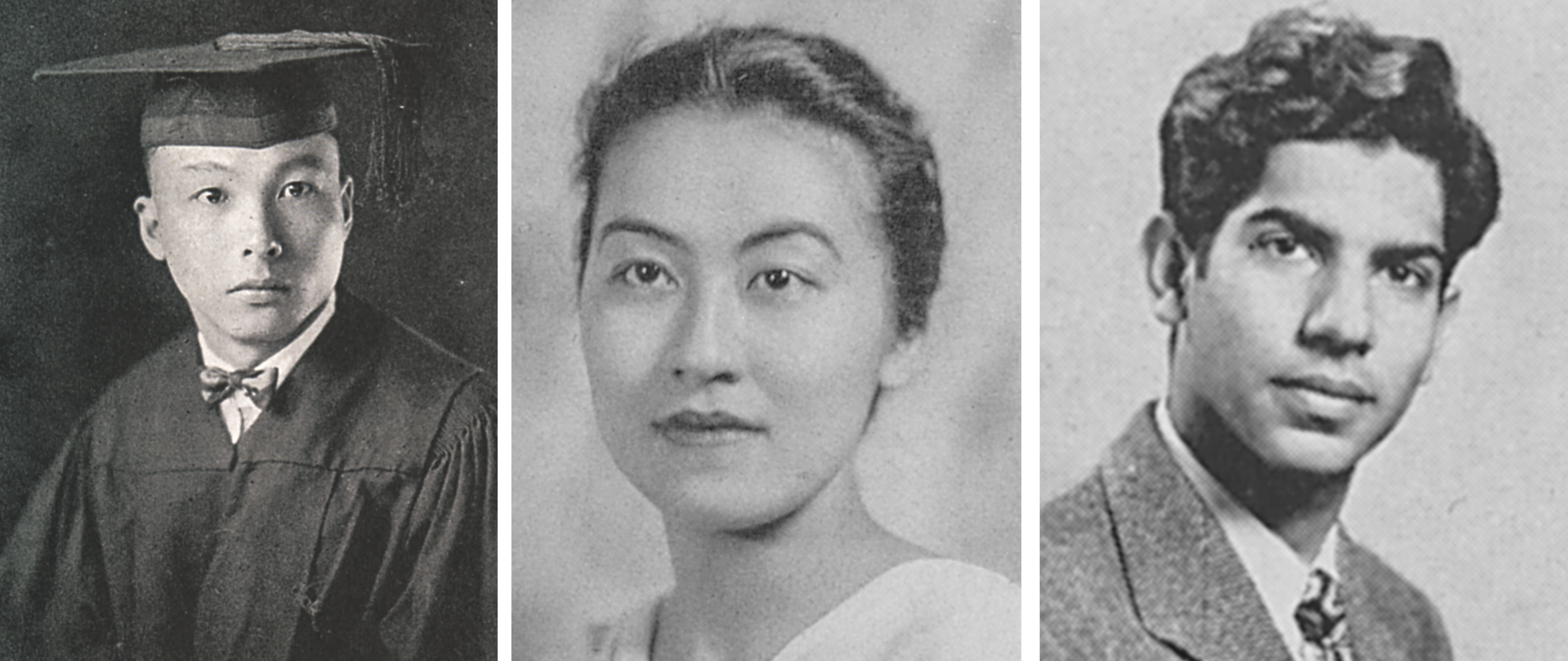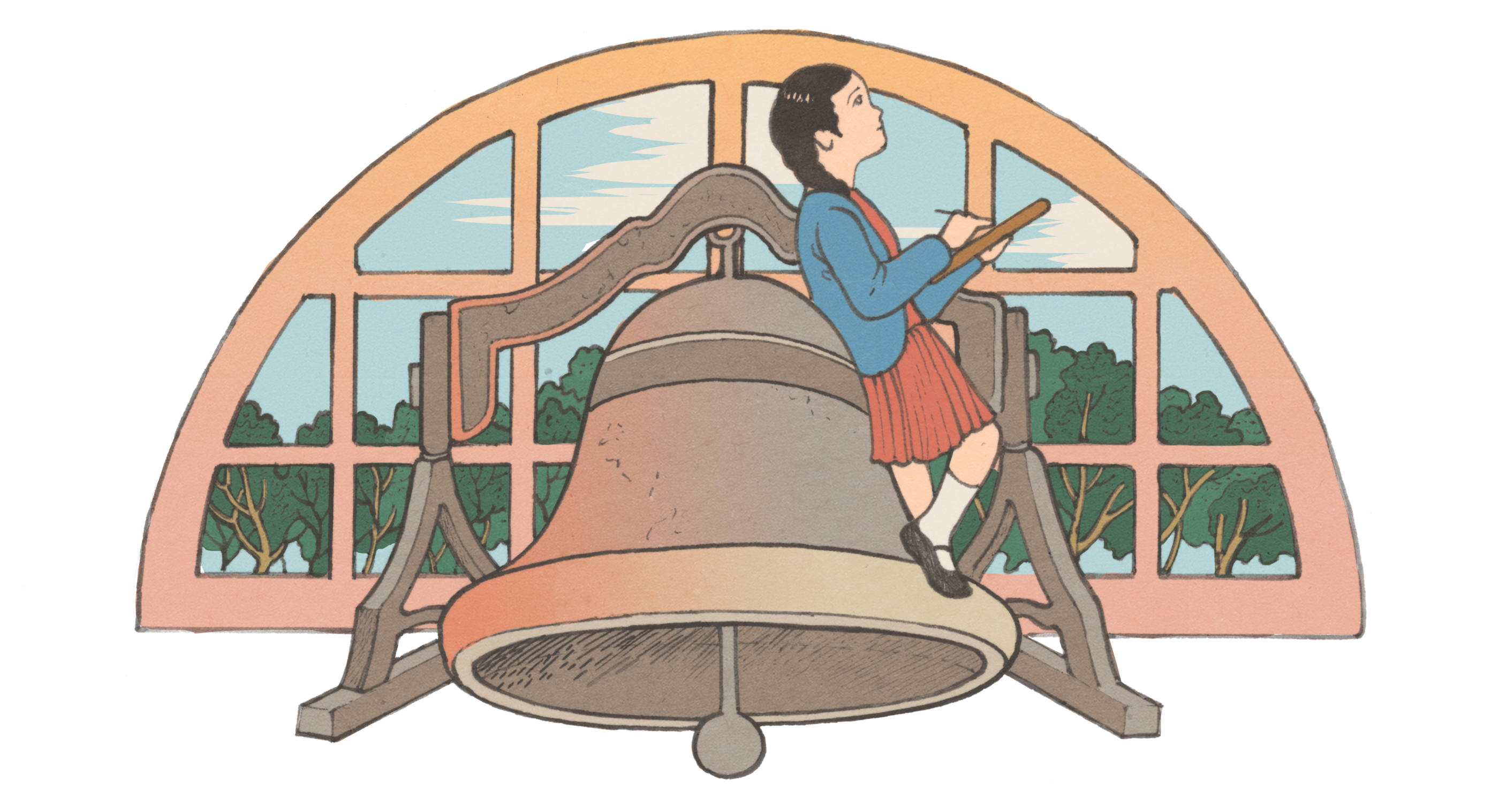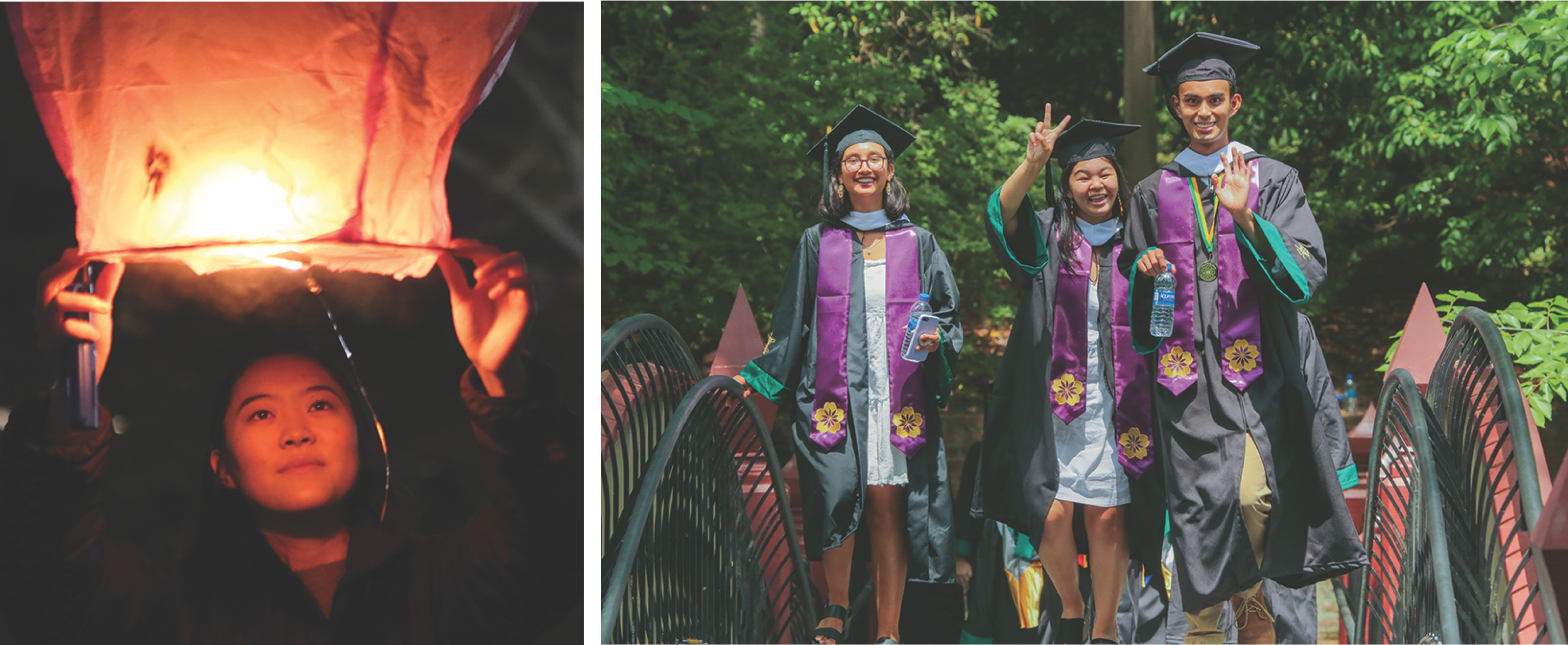Common Threads
Through W&M's Asian Centennial, students are discovering how the university's history intertwines with their own stories
September 15, 2021
By
Tina Eshleman
Illustrations By
Vikki Zhang
The wavy-haired young man in the black-and-white photograph looks at the camera with a half-smile and a slightly raised eyebrow. It’s stamped Jan. 9, 1926, but for a moment, the decades seem to vanish and one wonders what he might say about his time at William & Mary.
Benming “Benny” Zhang ’16, J.D. ’20 kept the picture close by during his senior year as he researched the life of Arthur A. Matsu ’27, a star quarterback and football team captain who was the first American citizen of Asian heritage known to attend William & Mary. A self-designed Asian American studies major, Zhang was writing his senior thesis on Matsu at the same time he was working toward breaking a barrier of his own — becoming the youngest and first Asian American person elected to Williamsburg City Council.
Questions circled in his mind: What was Art Matsu thinking at the time this photo was taken? Did he feel like he belonged at William & Mary? How did people react to his blended Japanese and Scottish ethnicity? Where did he live? How was he treated when he went out into the community?
These are some of the strands being explored about Matsu and other alumni as William & Mary commemorates its Asian Centennial. While recognizing the accomplishments of Asian and Asian American students at the university over the past 100 years, the commemoration also seeks to probe the social and historical context of their experiences.
The milestone provides an opportunity to contemplate the ways in which students of Asian heritage have enriched the culture of the university and how to expand on the advances that have been made thus far.
“People’s ideation, imagination and creativity should be informed by diversity,” says Asian Centennial co-chair Francis Tanglao Aguas, a professor of theater and Asian & Pacific Islander American (APIA) studies. “This is a commemoration of opening doors to more diversity.”

President Katherine Rowe established a committee in February to create programming and initiatives tied to the anniversary of when Pu-Kao Chen 1923 (also known as Chen Pu-Kao) — a Chinese citizen who was the first Asian student and first known person of color to attend William & Mary — arrived on campus in 1921. Along with Tanglao Aguas, the centennial is co-chaired by Deenesh Sohoni, a sociology professor and director of the APIA program, with guidance from honorary chair Michael Tang ’76, P ’13. The 20-member committee includes Board of Visitors member Mirza Baig P ’22 and representatives from schools and departments throughout the university. Zhang is one of the younger members of the committee, along with Isabella DiFulvio ’23, co-director of the Asian American Student Initiative, an organization dedicated to Asian American awareness, activism and solidarity with marginalized communities.
“We are hoping for the Asian Centennial to be a platform for William & Mary to become the leader in expanding academic programs and research that promote inclusion of Asian American, Pacific Islander and Southwest Asian students and communities,” Tanglao Aguas says.
The centennial also offers a chance for William & Mary to reflect on how the experiences of Native American and Black students intersect with those of Asian and Asian American students, he says.
Asian Centennial organizers received seed money from William & Mary Provost Peggy Agouris for the commemoration and have raised additional funds that faculty and students can use for research.
Eventually, Sohoni and Tanglao Aguas hope to secure private funding to support a postdoctoral fellow who can continue to do research with students and help to expand APIA course offerings. They are also working with partners at the William & Mary School of Education and the Virginia Governor’s Office to develop K-12 curricula on Asian American history.
A new Asian Pacific Middle Eastern/Southwest Asian Project Fund is being created to support initiatives across William & Mary focused on research, teaching, professional development, artistic creations, scholarships, fellowships and community engagement.
“We’re hoping that during the commemoration we can create something that’s sustaining,” Sohoni says. “We want to make sure that we also use it to build stronger connections between the different schools and departments at William & Mary.”
As a pilot program, two undergraduate students enrolled in an independent study course this past spring with Sohoni to find out more about the first students of Asian descent.
For current students with varied Asian heritage, delving into William & Mary’s past and their own history and culture helps to illuminate the connections between previous struggles and present challenges. Learning about W&M’s trailblazers also provides inspiration for today’s scholars and allows them to see how they fit into the evolving fabric of the university.
“It’s like when you get glasses for the first time and you realize you haven’t been seeing the leaves on the trees. I was seeing things in a new way and understanding things in a new way,” student researcher Sumié Yotsukura ’22 says of her APIA studies. “It’s not just history. It’s something we’re learning about so that we can, hopefully, make our future better.”

The First Student From China
Yotsukura and fellow researcher Brian Zhao ’23 focused their independent study during the spring 2021 semester on the first Asian students to attend William & Mary. With assistance from Jay Gaidmore, director of special collections for W&M Libraries, Yotsukura and Zhao scanned Colonial Echo yearbooks and delved into archives for the Flat Hat and other publications.
One of their main discoveries so far is an article written by Pu-Kao Chen that appeared in The William and Mary Literary Magazine in February 1923. Titled “A Chinese Student’s First Impression of America,” the piece opens a window into what it must have been like for a person their age to travel thousands of miles from home to attend school in a foreign country, knowing it would be several years before they returned.
Chen describes the mixture of excitement and apprehension that the students aboard the steamship “China” felt as they crossed the Pacific Ocean: “Everything they had hitherto loved was left behind. America with all her long-expected wonders was still far away.” Arriving in San Francisco, the Chinese students were greeted with a reception and Chen describes their delight at seeing the Golden Gate Bridge, the University of California campus, the lofty buildings and sunny streets.
Research for the Asian Centennial by Yusuf Jafri J.D. ’22, a third-year law student and research fellow with W&M’s Center for Racial and Social Justice, offers some historical context for Chen’s arrival in the United States. Under the directorship of Professor Vivian Hamilton, he looked into the effects of immigration laws on William & Mary’s first Asian and Asian American students, as well as the social environment they lived in.
Because of the U.S. Immigration Acts of 1917 and 1924, Jafri says, “People from large swaths of Asia were barred from emigrating to the U.S. unless they fell under certain exempt classes, and one of those was students who were coming here temporarily.”
After China’s defeat in the Boxer Uprising, an attempt in 1900 to drive all foreigners out of the country, a treaty required China to pay an indemnity worth over $300 million to an eight-nation alliance including the United States. In 1908, the U.S. returned some funds that were deemed excess through the Boxer Indemnity Scholarship Program to support education for Chinese students in America and the construction of Tsinghua University in Beijing. It is through those funds that students such as Chen came to William & Mary.
“Students were seen as potentially future political and economic leaders in China, and we wanted to make sure we maintained an open market with China,” Sohoni says.
Surprisingly, there doesn’t seem to be much in the Board of Visitors archives or presidential papers about the first Chinese students. Given the racial segregation that existed in Virginia at the time, the researchers expected to find evidence of discussion about issues such as where the students would live.
“The Jim Crow South was very much a Black-white racial binary,” Jafri says, but Asians and Asian Americans did not fit into either category. He found that acceptance of Asian and Asian American students at predominantly white schools varied widely across the South, sometimes from one locality to another.
Yotsukura applied her theater background to her research, looking for clues about what a character is experiencing, how others see the person and the influence of outside events.
“In the Flat Hat, up through the time when Art Matsu was on campus, for the most part, everything is very respectful,” she says. “But it’s the things that aren’t always quite as visible that can tell you a lot.”
For example, the year before Chen’s arrival, there was a joke in a Flat Hat column that referred to “John Chinaman,” a racial stereotype commonly used at the time, and transcribed his accent in a mocking way.
“The campus that published that type of joke in its paper is the same campus that welcomed, to our knowledge, the first Chinese student there next year,” Yotsukura says.
References to Chen and other Chinese students in the yearbooks are courteous, wishing them well on their return home, Yotsukura says, adding that the temporary status of the Chinese students may have made their presence more accepted.
“They’re not here to stay, which is why they’re not a threat,” she says. “That’s been a big thing in the history of Asian Americans in the U.S.”
In his literary magazine article, Chen praises the United States, but also offers a perspective on China that challenges his readers to look beyond what they might see in movie caricatures or in missionary accounts describing dire conditions in his homeland.
“America is indisputably the light of the world today,” Chen writes. “China wishes to be rightly understood, particularly to Americans at home.”
Yotsukura says that researching Chen at a time when he was about her age helped her relate to him as she and her peers work to combat prejudice through Stop Asian Hate and Black Lives Matter protests.

With the Cooperative Change Fund established by students this past year, campus organizations at W&M came together to raise money for police reform efforts such as the National Police Accountability Project and Campaign Zero, and for the families of the eight people killed — most of them Asian women — in the March 2021 shooting rampage in the Atlanta area.
“With COVID-19 and the scapegoating of China, we saw a lot of very blatant anti-Asian and anti-Chinese racist and xenophobic hate that people are still trying to fight,” she says. “Chen’s words are a reminder that we are not alone, but also that we have been fighting this fight for a long time.”
Yotsukura, whose paternal grandparents emigrated from Japan, feels a particular connection with Matsu and with Hatsuye Yamasaki ’37, the first Asian American woman to attend William & Mary, who participated in the Judicial Council and served as president of Brown Hall and secretary of the Spanish Club.
“It gives me pride to know that people of my heritage go back that far at William & Mary,” Yotsukura says. “I am stepping into the shoes of people who have been where I am now.”
After graduating from William & Mary, the theater and APIA major hopes to make an impact of her own by pursuing theater work that will draw attention to issues of social justice and increase accessibility of performances for diverse communities.
“I’m a big believer that seeing stories of people unlike yourself can have a huge impact on opening people’s perspectives and hearts,” she says.
Likewise, Jafri, whose family has roots in Pakistan, is thankful for people such as Asghar Ali ’54, of Lahore, Pakistan, who paved the way for students like himself.
A 1952 interview with the Flat Hat reveals that Ali hoped to become a mechanical engineer and describes him as being a whiz on the tennis courts and swinging “a mean ping pong racket.”
“These people created a foothold for future generations,” Jafri says of Ali and others like him. “It’s not lost on me the work that these students have been putting in since 1921 to create an environment where I can feel comfortable. I appreciate looking back in time and seeing their contribution to creating the environment today.”
Sohoni asked Yotsukura to create a template for an exhibit based on their findings. Over the summer, she worked on converting the assignment into an exhibit that could be displayed at Swem Library this fall.
The next step in the students’ research will be to reach out to sources outside William & Mary. For example, Zhao is contacting Tsinghua University in China, where Chen and other students received training in English before traveling to the United States, to find out if there are any photographs of the students who came to William & Mary.
“We’re trying to see if we can find information before they arrived here and what happened after they returned to China,” Sohoni says.
Zhao says there are hints that Chen may have become a playwright or filmmaker, something he hopes to further research in China, where Zhao’s mother grew up and his grandmother still lives. After graduating, he plans to go into teaching and share some of what he’s learning with high school students — a goal that ties in well with the Asian Centennial plans to promote curricula in K-12 schools.
“I would describe archival research as sort of putting together a puzzle,” he says. “There are all these different disparate pieces. We’re trying to figure out one person’s life and situate them in the historical context of the time.”
The Football Champion
What was written in news stories about Art Matsu focused on his achievements on the football field, and there, he was an undisputed hero. Articles in the Flat Hat and other newspapers praised his athletic feats, according to Zhang’s research.
Already known as a star athlete in high school, Matsu reportedly had considered attending Princeton University, but William & Mary football coach J. Wilder Tasker promised that he could play immediately.
Off the football field, Matsu was part of Omicron Delta Kappa, Alpha Kappa Psi, the Order of the White Jacket and the secretive 13 Club. He served in leadership roles for the Monogram Club and as secretary of his freshman class.

But there were hints that he was viewed differently than other players. In his research, Zhang found news coverage from outside the Williamsburg area that referred to Matsu as a “Jap Quarterback” even though he was born in Glasgow and his mother was Scottish. Matsu’s family moved to Canada and then to Cleveland, Ohio, where he grew up.
In Virginia, the environment outside of William & Mary was less than welcoming for students such as Chen and Matsu. The Racial Integrity Act passed by the Virginia General Assembly in 1924 prohibited interracial marriage and defined a white person as someone “who has no trace whatsoever of any blood other than Caucasian.” The law would have made the marriage between Matsu’s parents illegal, had they lived in the state.
During the time that Chen and Matsu attended William & Mary, the Ku Klux Klan and Anglo Saxon clubs were growing in popularity in southeastern Virginia and were targeting immigrants and Catholics in addition to Black citizens. “It was the second wave of the KKK,” Jafri says.
In the same issue of the Flat Hat that carried an article with the headline “Matsu to Davis Passing Combination Again Proves Its Worth” on Sept. 24, 1926, another headline described the presentation of an American flag and flagpole to William & Mary from the KKK: “Imperial Wizard Evans Heads a List of Ku Klux Klan Notables Who Will Attend Presentation.”
During the presentation of the flag, Julian A.C. Chandler, then William & Mary’s president, made remarks to the 6,000 spectators denouncing “the bigotry and intolerance which exists in our nation today.”
In addition to Zhang’s thesis, William & Mary’s recorded knowledge of Matsu is being expanded through conversations with his daughter, Nancy Matsu Hulse. After President Rowe led the effort to locate Art Matsu’s family, W&M oral historian Andre Taylor conducted an interview with Hulse on Oct. 8, 2020.
As part of the Asian Centennial, organizers expect to hold a formal opening of the Arthur A. Matsu Arcade, an arched walkway at Zable Stadium, at one of the football games this fall. The Board of Visitors voted in April to name the arcade in honor of Matsu, who played in the NFL for the Dayton Triangles after graduating from W&M and later became a coach at Rutgers University. He died in 1987 at age 83.
Matsu also will be commemorated with a new Virginia historical highway marker, Gov. Ralph Northam announced in August. Students from Cumberland Middle School researched Matsu and nominated him as part of a contest to recognize Asian American Pacific Islander history in the state.
On May 4, 2016, Zhang delivered his thesis presentation on Matsu — one day after winning election to the Williamsburg City Council and witnessing the Faculty of Arts & Sciences vote to approve Asian & Pacific Islander American studies as a minor.
“If there’s one word to encapsulate what the Asian American studies major did for me, it helped me develop a deeper sense of empathy,” says Zhang, now an attorney with Kaufman & Canoles in Williamsburg. “It helped me shape how I think.”
That background was particularly useful during his last few months of his City Council tenure in 2020, when there were nationwide protests in response to the police killing of George Floyd in Minneapolis, he says. Relating what he had learned in Asian American studies helped prepare him to speak with citizen groups and work with then-Mayor Paul Freiling ’83, P ’21 to craft the city’s response.
“A lot of thought, a lot of work and a lot of the training I got from my major went into that,” he says. “Having that knowledge from my undergraduate studies really was important.”
Just as Matsu inspired him, Zhang says he hopes that in the future, students will be encouraged by his accomplishments.
“I don’t think Art Matsu would have wanted to be emulated, and I certainly wouldn’t want folks to emulate me, either,” he says. “Rather, we hope that our narratives inspire others to find their own voices and forge their own paths.”
A Vibrant Community
After Chen and Matsu, Yamasaki and Ali came many others. The late Rear Adm. Ming Chang ’55 was a decorated naval officer who later became a corporate executive. Stephen Tang ’82 is CEO of Philadelphia-based OraSure Technologies, which produces over-the-counter, at-home testing kits for COVID-19, among other products. Florida Rep. Stephanie Dang Murphy ’00 arrived in the United States as an infant when her family fled Vietnam and in 2016, she became the first Vietnamese American woman elected to Congress.

According to W&M’s Office of Institutional Research, Asian Americans make up about 8% of the university’s student population. The university’s Asian-Pacific Islander-Middle Eastern/Southwest Asian (APIM) alumni base is estimated at more than 4,000. Leaders of the new APIM alumni network held their first meetings in early 2021 and are working to increase the group’s visibility and strengthen its members’ connection to William & Mary. (Read more about APIM leaders and their plans in our online exclusive "A Core Component of William & Mary's Identity.")
Tanglao Aguas has been a strong advocate for expanding Asian studies at William & Mary and nurturing the growing community of Asian American students. When he came to William & Mary in 2005, he was the only Filipino faculty member, and there was just one Asian theater student.
“I saw that as an opportunity to create a platform for diversity and that’s been my work — 16 years of diversifying not only the physical landscape and the academic landscape, but also the creative landscape,” he says.
In 2009, Tanglao Aguas became the first faculty member of color in the arts to receive tenure and in 2016, the first to become a full professor. Sohoni helped Tanglao Aguas build the APIA program and is now the director, while Tanglao Aguas is head of global studies. APIA studies became an official minor in 2016 and a major in 2019. To date, there have been more than two dozen students in the program.
In 2019, Zhang’s parents, who emigrated from China and opened a medical practice in New York City, established the Jinlan Liu APIA Faculty Research Endowment, named in honor of Zhang’s mother, to support the program. All of the APIA faculty members are eligible to receive research grant funds through the endowment. In announcing the endowment, Jinlan Liu P ’16 expressed the hope that it “will further disseminate America’s complex history with Asian Americans and provide solutions for the challenges Asian Americans face today.”
Also in 2019, William & Mary became the only public university in Virginia to offer a Japanese studies major, under the Department of Modern Languages & Literatures.
The first student to graduate with a self-designed Asian American studies major was Edward Hong ’09, now an actor and producer living in Los Angeles. Hong, who was born in California and attended high school in Seoul, South Korea, before coming to William & Mary, gave the 2020 virtual commencement address for APIA graduates.
In his speech, Hong talked about the transformative role that Tanglao Aguas and Asian American studies played in helping him find his career path. A turning point came during the class “Sex and Race in Plays and Films,” in which the final project was about identity. Hong had been struggling with his emotions as a young Korean American in the aftermath of the Virginia Tech shootings in April 2007, and Tanglao Aguas encouraged him to express himself through writing.
Hong says he was nervous about how others would respond if he shared his inner turmoil, but when he finished making his presentation, he was surprised to see the entire class in tears. Instead of treating him as an outcast, his audience of fellow students and their friends gathered around him in support.
“Because of that, I knew I wasn’t alone,” he says. “From this point, Francis and I and many others created a vibrant niche that has become what you see before you now.”
Hong’s experience led him to collaborate with Tanglao Aguas on forming a diverse performing arts group and designing his own Asian American studies major. He called on the 2020 graduates to fight for justice while extending compassion to others, to lean on each other when times are tough and to take care of themselves so they don’t burn out.
“This major that you have is more than just a degree,” Hong told the graduates. “The major carries knowledge and the foundation of those whose shoulders you stand upon. Ultimately, it carries power.”
Eyes on the Future
Angelique Vo ’22 says her APIA classes at William & Mary have encouraged her to explore her identity and culture as it relates to the history of Asian Americans in the United States. This was a contrast from her grade-school years, when she did not see much evidence of her Vietnamese heritage in the curriculum.
“I feel like I can see myself now in my position in society,” she says. “I can see what my rights are and how they have been affected by greater forces.”
Seeing things in a new way has influenced Vo’s thinking about her career path. In addition to the neuroscience studies she’s been pursuing, she recently decided to declare an APIA major. Vo hopes to become a physician assistant who can address health care disparities that adversely affect Asian Americans.
In an effort to increase the visibility of Vietnamese American students at William & Mary and help incoming students who share their heritage feel more at home, Vo and three other students — Kenneth Tieu ’23, Brandon Nguyen ’24 and Lemai Vo ’21 — established a Vietnamese Student Association last spring. Among their activities was a Tet new year celebration in which participants delivered lanterns filled with goodies to an assigned partner.
The VSA joins a variety of other Asian American student groups, including the Chinese Student Organization, the South Asian Student Association, the Filipino American Student Association, the Japanese Culture Association, the Korean American Student Association and the Asian American Student Law Association.
Like Vo, Melina Rice ’23 says that taking an APIA class helped her to make sense of her own experiences. Rice, who is Filipino American, would like to see the program expand its courses on subjects such as Filipino history and attract more students.
“I hope we would be able to have more resources available because I’m very interested in that,” says Rice, a film and media studies major.
Vo hopes the Asian Centennial will encourage all students to learn more about the history of Asians and Asian Americans at W&M.
“Continually educating yourself on those narratives is important,” she says. “The more people learn, the more changes will happen.”
